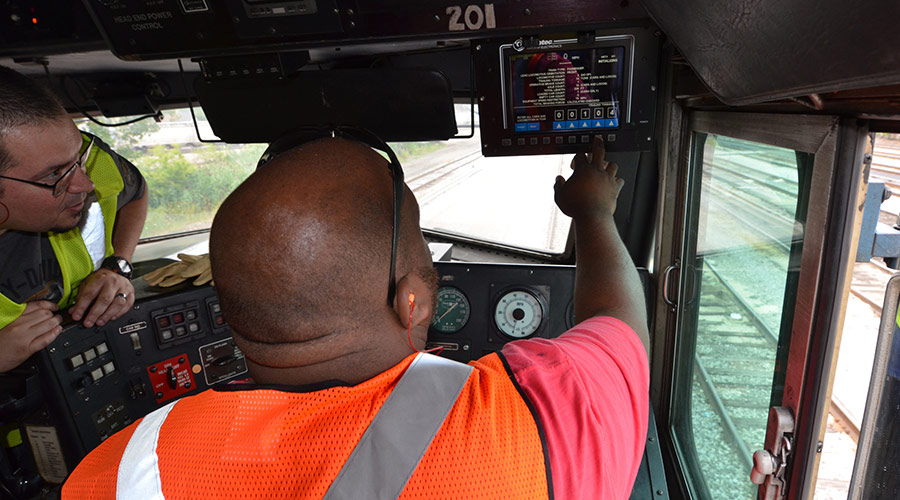Stay updated on news, articles and information for the rail industry
October 2007
Rail News: PTC
Positive train control in transition
The rail industry’s search for an interoperable communications-based train-control system is a quarter-century old. Yet, the hunt for an affordable system that helps safely control a train from one railroad’s network to another hasn’t registered much success since the early 1980s, when railroads tried to employ an Advanced Train Control System.
But positive-train control (PTC) system suppliers GE - Transportation, Safetran Systems Corp. and Union Switch & Signal Inc. (US&S) believe their jointly developed Communications-Based Signaling (CBS) could bring the quest to an end. An interoperable radio- and signaling-based vital train-control system, CBS is designed to provide continuous overspeed protection, govern the safe movement of trains through a territory and secure communications between different substations.
The system, which soon will enter the lab demonstration phase, also can protect roadway workers and reduce human errors associated with movement authorities, train orders and track warrants, the suppliers say.
GE, Safetran and US&S recently developed draft manual parts for CBS. Their joint effort — which initially included Alstom Signaling Inc. as an ad hoc participant — began in fall 2005, when railroads asked the American Railway Engineering and Maintenance-of-Way Association (AREMA) to define an interoperable radio-based cab signal system. The association assigned the task to AREMA Committee 37, which governs signals and train-control systems. Committee members, comprising representatives from railroads, suppliers, consultants and regulators, then reached a consensus to develop a communications-based signaling system.
In the first of a two-part series on PTC, Progressive Railroading chronicles the suppliers’ attempt to fill the interoperability void, as well as their individual efforts to provide PTC systems offering numerous safety and operational efficiency benefits.
Signaling a change
GE, Safetran and US&S designed CBS to operate the same as a conventional cab signal system with the following exceptions: physical blocks, as determined by track circuits in conventional systems, are replaced by virtual blocks close in length to track circuits in Centralized Traffic Control (CTC) territory; a radio frequency communications data link transmits vital cab signal information instead of through the rails; and train location is determined as an on-board function.
The equipment and labor costs to install and maintain CBS would be comparable to or less than maintaining an overlay system because railroads could upgrade non-signaled territory to a radio-based CTC operation or upgrade a wayside signal system to onboard displays with enforcement, the suppliers say. In addition, CBS would be available from multiple suppliers.
CBS could be installed as a stand-alone vital system or used in conjunction with overlay systems currently being tested by the rail industry, such as those in existing CTC or dark territory.
“Putting in a non-signaling-based system is a short-term solution. Eventually, there’s a desire to replace wayside signaling components,” says Bill Petit, Safetran’s vice president of technology, who retired on Sept. 28. “CBS uses new technologies to implement vital PTC by extending the use of signaling principles that have been in service for 150 years.”
CBS’ subsystems include a computer-aided dispatch system, form translator, signaling logic and on-board logic processors, communication links and an infrastructure database.
“We’re combining together proven technologies,” says US&S Chief Technologist Chinnarao Mokkapati.
CBS could be used by freight or passenger railroads, including light- and commuter-rail agencies.
“It would be ideal for a commuter railroad using a freight railroad’s lines,” says Petit.
The suppliers believe CBS would be an ideal interoperable solution because the system incorporates signaling principles, and currently accepted vital processing and CTC dispatching techniques to enable railroads to change underlying operating methods, program the application logic and control their own operations — eliminating the need for all railroads to maintain common operating rules — as well as access common train-control operations across a territory regardless of train operating density.
AREMA Committee 37 currently is reviewing the draft manual parts and will consider granting approval at meetings to be held Oct. 29-30. Last month, the Federal Railroad Administration (FRA) approved a $500,000 grant — through the Association of American Railroads-administered Railroad Research Fund — for a lab demonstration, which could be completed by late 2008.
The lab test will verify the manual parts’ interoperability and demonstrate the system’s operation, says Petit. The test also would mark Alstom Signaling’s return to the joint effort.
“When it gets to the lab demonstration, we will participate in that,” says Alstom VP of North American Products Jim Balliet.
If the demo is successful, the CBS development team plans to conduct a live field test and make initial lab test equipment available to all suppliers that wish to test their systems for interoperability, says Petit. Once all tests are completed, the suppliers plan to offer CBS as well as their own PTC systems.
“The thinking is that we all would migrate to a communications-based system,” says Petit.
A ‘vital’ component
In addition to helping develop CBS, US&S is addressing interoperability while designing its own PTC system. The supplier is building interoperability into the Vital Positive Train Control (VPTC) system, says Mokkapati.
Next year, the Alaska Railroad Corp. will begin full FRA acceptance testing on VPTC, which will be the first vital PTC system installed in dark territory, says US&S Project Manager for Alaska PTC Brian Kornish. The system will cover more than 500 miles of track, of which 90 percent is in dark territory.
In-track tests with the FRA could begin in the fourth quarter, followed by site testing in the first and second quarters. FRA acceptance testing is slated to begin in fall 2008.
“We want to wait until after their peak passenger season ends in September,” says Kornish.
To install VPTC, US&S will extend the railroad’s computer-aided dispatching system and install computers on board more than 65 locomotives to support electronic authorities.
For the past few years, CSX Transportation and Norfolk Southern Corp. have been relying on Safetran’s Geographic Signaling System (GEO®) to safely control trains in cab signal territory.
A vital microprocessor-controlled train-control system Safetran has marketed the past five years, GEO generates an electronic DC-coded track circuit and operates intermediate signal locations and single or multiple switch interlockings. The system is designed to support coded-track and coded-line applications, and vital, radio-based signaling.
Safetran recently upgraded GEO’s logic board to improve system speed, says Petit.
In addition to system speed, train speed is a primary issue surrounding Amtrak’s use of GE – Transportation’s Incremental Train Control System (ITCS) in Michigan. Early next year, Amtrak and GE officials expect the FRA to approve a petition that would enable the national intercity passenger railroad to operate trains on ITCS-enabled lines at speeds up to 110 mph.
Amtrak currently uses the system on a 45-mile stretch in Michigan along its Chicago-to-Detroit corridor, where trains reach speeds between 90 mph and 95 mph. For the past seven years, the railroad has used ITCS as an overlay to an existing block signaling system.
During the next two years, the railroad might extend ITCS another 20 track miles in Michigan.
“It’s a matter of funding,” says Bill Oberkramer, GE’s product manager for advanced train-control systems. “Amtrak also is looking at extending the system longer than 20 miles.”
At a crossroad in Illinois
In addition, Amtrak, along with Union Pacific Railroad, is considering a plan to install an ITCS subsystem at 86 grade crossings along a 100-mile stretch of the IDOT Corridor between Chicago and St. Louis. The railroads would install high-speed crossing activation systems between Springfield and Mazonia, Ill.
The project culminated from the fall out of the North American Joint Positive Train Control Project, says Oberkramer. Previously proposed by the FRA, AAR and Illinois Department of Transportation, the project had called for installing a PTC system on a 120-mile segment of UP-owned track along Amtrak’s Chicago-to-St. Louis corridor.
“They’re no longer looking for a full PTC system,” says Oberkramer. “We expect to start the proof-of-concept phase this year and implement the crossing activation systems next year.”
GE also is in the running to provide ITCS to Canadian Pacific Railway, which currently is evaluating several PTC systems, says Oberkramer.
GE already completed a major ITCS installation outside North America. In June, the company finished installing the system on more than 680 miles of track in Tibet. To complete the project, GE faced one of the most difficult rail operating environments in the world, where air temperatures range from below zero to more than 70 F and altitudes range from 11,000 to 13,000 feet, says Oberkramer.
The installation proved successful by holding up to harsh elements and demonstrating PTC can work well without wayside train detection, such as track circuits, he says.
From South to North America
Alstom Signaling also is targeting a train management at markets inside and outside North America. The company is redesigning the Optimized Train Management System (OTMS™) it deployed on 5,000 miles of track in Brazil earlier this year for the North American market.
OTMS would be the first in North America to offer dark territory control, optimize signaled territory control and provide PTC all in one system, says John Schultz, Alstom’s VP of business development-signaling.
“All three are plug-and-play components essentially,” he says.
OTMS also offers advanced scheduling and traffic planning features. The system can use a wide or local-area network to provide switch position, work-zone location or movement authorities in real time. Alstom plans to finish developing a working OTMS demo for the North American market sometime this month, says Schultz.
In the meantime, Alstom is trying to convince Amtrak to upgrade radio communications with higher bandwidth for the Advanced Civil Speed Enforcement System (ACECS) the railroad has used on the Northeast Corridor since 2001. The change would improve communication between the transponder and train.
In terms of a comparison, information moves through what’s now a half-inch water pipe when it could move through a 42-inch water main, says Schultz.
“But it’s a cost vs. benefits concern for Amtrak,” he says.
Northeast Corridor users CSXT, NS and the Massachusetts Bay Transportation Authority also tie into ACECS — the only PTC system in revenue service that’s used on a daily basis, says Schultz.
An overlay to an existing cab signaling system, ACECS is a modular on-board and wayside PTC system designed to provide safety functions while allowing train speeds up to 150 mph. The system uses passive transponders to enforce speed restrictions and governs positive train stops at interlocking signals.
“It’s really an insurance policy of sorts for Amtrak,” says Schultz. “It allows them to operate safely at high speeds and protect workers.”
All railroads are hoping to derive similar safety benefits from PTC. But until they’re convinced it’s the right system at the right cost — and one that meets FRA safety requirements — most roads are content to wait on the sidelines. 


 2025 MOW Spending Report: Passenger-rail programs
2025 MOW Spending Report: Passenger-rail programs
 Gardner steps down as Amtrak CEO
Gardner steps down as Amtrak CEO
 Guest comment: Oliver Wyman’s David Hunt
Guest comment: Oliver Wyman’s David Hunt
 Women of Influence in Rail eBook
Women of Influence in Rail eBook
 railPrime
railPrime







